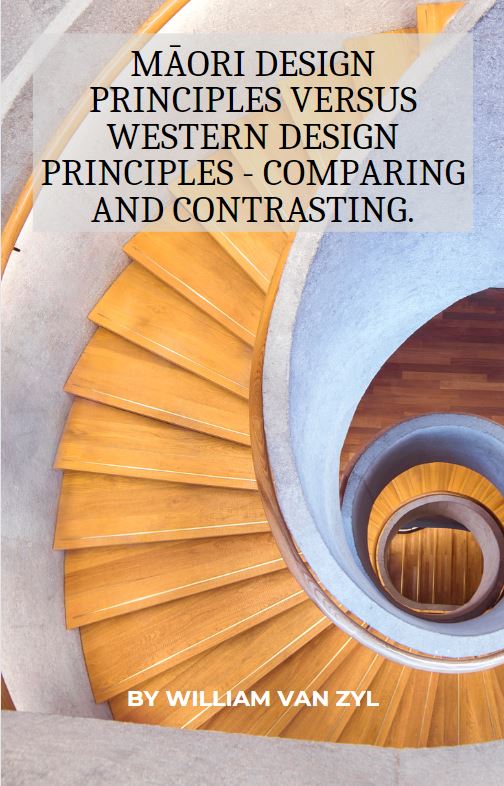
By William Van Zyl (published 20 August 2023).

Table of Contents
For Designers, artists, architects, and Design and Visual Communication (DVC) students.
This article provides an overview of an indigenous culture’s design approach: New Zealand Māori.
I contrast and compare this cultural and spiritual approach with a typical Western World Design approach. It sheds light on the Māori (New Zealand’s indigenous people) way of design and shows their interpretation of the world. Furthermore, I compare Māori Design Principles with General Design Principles. Then, I look at patterns – specifically the Flounder Fish (diamond shape) pattern – and some modern NZ buildings that reflect this specific pattern. I also touch on abstract design concepts and ideas for architecture – using Māori abstract art as inspiration. Lastly, I touch on using AI for design ideas (Playground AI). See the stunning design images created by Playground AI with the Māori Flounder Fish pattern (diamond shape) as the focus. The AI prompt included ‘a modern contemporary house with many Māori shapes, forms and patterns.’ This resource concludes and culminates with a spectacular design at the end! Don’t miss it.
DVC NCEA LEVEL 1 New Zealand (New Curriculum starting in 2024).
The new Design and Visual Communication (DVC) NCEA Level 1 – New Zealand requires students to consider a Māori design perspective in their work. In this article, I look at the Māori design principles that differ slightly from the Western World Model. For other cultures it provides a paradigm – and a lens – through which own cultural design differences can be identified. For example Australia – Aboriginal design principles versus the Western World Model.
Keywords and key phrases:
Māori design principles
Te Aranga Design Principles (TADP)
Te Ao Māori (the Māori world)
Te Ao Hurihuri (the changing world)
Māori design principles are deeply rooted in the local culture and context of New Zealand.
interweaving cultural, spiritual, and environmental dimensions
symbols, patterns, and colours to convey ancestral stories
functionality
intricate carvings, patterns, and colours for aesthetic appeal
ancestral connections
spirituality
indigenous values
closely aligns with nature and the environment
holistic approach
rangatiratanga
kaitaiakitanga,
manaakitanga,
wairuatanga,
kotahitanga,
whanaungatanga
Mātauranga
PATTERN MIMING THE FLOUNDER FISH (NZ): This development, with its façade animated with a woven screen referencing pātiki (flounder), establishes a successful tēina / tuākana (mentoring relationship) to the Vinegar Lane precinct (location New Zealand). It raises the design bar high by meeting the challenge for entry-level housing within a high-density urban development. Aria Apartments. TOA Architects. Vinegar Lane, Auckland, New Zealand. Credit: https://www.nzia.co.nz/awards/local/award-detail/7577
Pātiki (flounder) shape, form and pattern:
Credit: https://my.christchurchcitylibraries.com/puawaitanga-o-te-ringa/patiki/
Pātiki or pātikitiki (flounder) designs are based on the lozenge or diamond shape of the flounder fish. They can be quite varied within the basic shape. According to Ngāti Porou tradition, the pātikitiki significance relates to providing 100% – for the husband or the whānau and the whole iwi. It acknowledges the fact that women were always looking for ways to supplement their food supplies, even in the dark when the flounders came while their men were sound asleep. Credit: https://my.christchurchcitylibraries.com/puawaitanga-o-te-ringa/patiki/
New Zealand Sand Flounder. Credit: https://en.wikipedia.org/wiki/New_Zealand_sand_flounder
Te Āhurutanga- – The University of Waikato, Hamilton: Application of Maori-shape, form, pattern and colour (‘The Flounder’).
ABOUT THE BUILDING AND THE MAORI ARTWORK: Te Āhurutanga’s name embraces concepts of “sheltered haven, calm and protected surroundings, a place to gather strength from each other.” It was opened in 1988 as a support and study space for students from the university’s rapidly growing Māori Department.

IMAGE: Reception desk – Flounder shaped artwork on the front panel. See more artwork and explanations on the symbolism in the article. Link to the article: https://www.pauaarchitects.co.nz/projects-te-ahurutanga/

IMAGE: Close up of the flounder-inspired panel at reception (front of the desk). Colours: Red, blue ( paua laminate), copper. Native timber edging. Baby corrugated steel background (silver colour): The silver of the baby corrugated iron equates to Te Marama (the moon), feminine principle or ira wahine.
DESCRIPTION:
Reception desk panel: ‘Patikitiki’
The central pattern is based on the Patikitiki design. The design itself, which is based on the flounder fish, indicates favourable harvests and abundant food, good weather and favourable times.
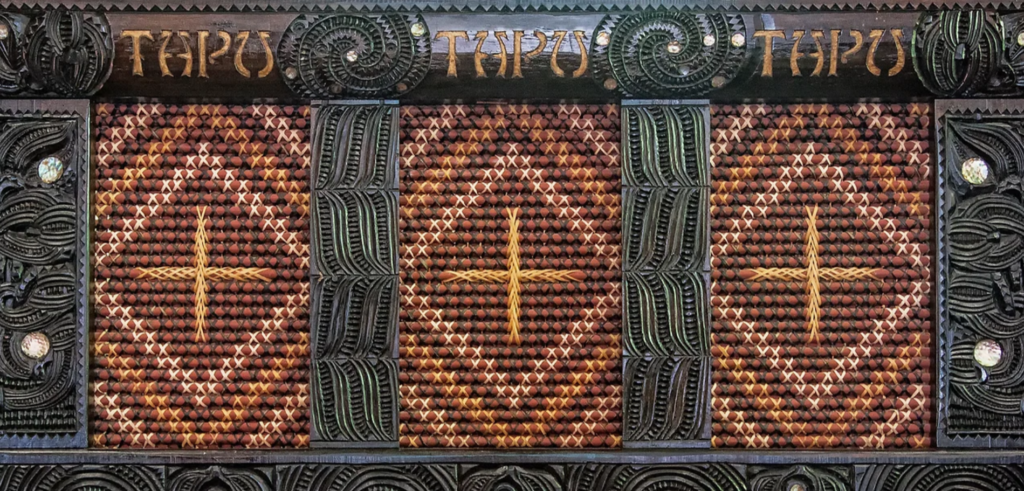
IMAGE: This artwork is not part of the Maori building at Waikato University. It is the banner of the Anglican Church (Ohinemutu, Rotorua – NZ). I include the tukutuku panel (diamond shapes) with a cross in the middle (Christianity) here to show how the Christian Faith was embedded into the Maori Art and Culture (‘The Flounder’ – square/diamond shape with the Cross in the center).
I include an excerpt from the church’s website (landing page) – showing how Christianity is embedded in Maori symbolism:
The image of Jesus Christ knocking on a door (with no handle) is a reproduction of the art work The Light of the World created in 1853 by Pre-Raphaelite artist Holman Hunt. It becomes a centrepiece for worship, beautifully balanced by geometric tukutuku panels with the design called poutama or stairway to heaven. They bring together Māori and European art traditions in an arrangement of lovely proportions.
The tukutuku panels on the front of the altar are in the design pātiki – representing the flounder fish and the proverb ‘the patiki once disturbed never returns to that place again’. The tukutuku crosses on the front of the altar represent commitment to the Christian life, and the words Tapu Tapu Tapu – Holy, Holy, Holy, are words of the Sanctus, the ancient Eucharistic prayer.
Credit: Anglican Church website. Link: https://www.stfaithsrotorua.co.nz/art-culture
For me the beauty is the symbolism of the door without a handle. Only the person on the inside can open the door.
Revelation 3:20 (New Berean Bible)
Behold, I stand at the door and knock. If anyone hears My voice and opens the door, I will come in and dine with him, and he with Me.
Symbolism of the colours in and around the Māori-inspired building: Waikato Uni – Māori-themed artwork.
The silver of the baby corrugated iron equates to Te Marama (the moon), feminine principle or ira wahine.
The copper colouring equates to Te Rā (the sun), masculine principle or ira tāne.
The red represents the taha kikokiko, our physical side.
The blue represents the taha hinengaro, our mental capacity and emotions.
The native timber framing is likened to Tāne Whakapiripiri and represents the conjoining of life.
Credit: James Webster (Artist)
Back to the main focus: Design Principles.
Te Aranga Design Principles:
DIAGRAM: TE ARANGA DESIGN PRINCIPLES. Credit: https://www.futurestreets.org.nz/mana-whenua/
The Te Aranga Design Principles (TADP), which have evolved from the TADP strategy, address the processes of economic, social, environmental and spatial development changes. They are a set of outcome-based principles founded on Māori cultural values and formulated to provide practical guidance for enhancing outcomes for the design environment.
The core values of rangatiratanga, kaitaiakitanga, manaakitanga, wairuatanga, kotahitanga, whanaungatanga and mātauranga (leadership, hospitality, spirituality, unity, relationships, and Māori knowledge) are important to understand as it is the way of engaging and collaborating within Te Ao Māori (the Māori world) and within Te Ao Hurihuri (the changing world).
Comparing and Contrasting: Māori Design Principles and General Design Principles.

Design principles are a set of guidelines that help designers create more aesthetically pleasing and functional designs. Design principles are usually not written down formally, but instead, they are learned through observation and practice. This is because there is no one set of design principles that applies to all designs. Every design problem needs its own solution. By Sowmiya V Link: https://sowmiyeh.medium.com/the-complete-guide-to-17-key-principles-of-design-and-how-they-can-help-you-create-a-compelling-7d25b913772e
Similarities:
- Cultural Significance: Both Māori design principles and general design principles emphasise the cultural significance of design. While Māori principles are rooted in the indigenous culture of New Zealand, general design principles acknowledge the importance of cultural context in shaping design decisions.
- Meaningful Communication: Both sets of principles recognise the importance of design as a form of communication. Māori design principles use symbols, patterns, and colours to convey ancestral stories, while general design principles focus on effective communication through visual elements.
- Functionality: Both Māori and general design principles consider functionality. Māori design ensures that structures serve the intended cultural and practical purposes, while general design principles prioritise creating functional and user-friendly designs.
- Aesthetics: Both approaches appreciate aesthetics. Māori design principles incorporate intricate carvings, patterns, and colours for aesthetic appeal, while general design principles seek visually pleasing and balanced outcomes.
Contrasts:
- Cultural Context: Māori design principles are deeply rooted in Māori culture, emphasising ancestral connections, spirituality, and indigenous values. In contrast, general design principles apply universally across different cultures and contexts, often prioritising a global aesthetic.
- Values and Beliefs: Māori design principles are influenced by core Māori values like manaakitanga (hospitality) and kaitiakitanga (environmental stewardship). General design principles may not inherently reflect specific cultural values but may incorporate ethical and sustainable considerations.
- Narrative: Māori design principles often incorporate narratives of ancestry and spirituality, telling stories through carvings and patterns. General design principles may focus more on creating a visual narrative that resonates with a broader audience.
- Approach to Nature: Māori design closely aligns with nature and the environment, utilising natural materials and embracing sustainability. General design principles vary in their approach to nature, with some emphasising eco-friendly practices while others may prioritise aesthetics over ecological considerations.
- Holistic Perspective: Māori design principles often take a holistic approach, interweaving cultural, spiritual, and environmental dimensions. General design principles may primarily emphasise visual elements, functionality, and market appeal.
- Local vs Global: Māori design principles are deeply rooted in the local culture and context of New Zealand. While adaptable to local contexts, general design principles are often designed with a more global perspective to cater to diverse audiences.
Summary:
Māori design principles and general design principles share common aspects, such as functionality and meaningful communication. However, Māori design principles are distinct in their emphasis on indigenous culture, spirituality, and local values, whereas general design principles are more universal in nature, catering to broader aesthetic and functional considerations.
It means that if a designer – including students – want to incorporate Māori concepts and ideas into their design work, they have to focus on Māori Culture, Spirituality, Values and Beliefs. They have to identify the shapes, forms, patterns, and colours that represent these aspects – place a cool modern contemporary twist on it – and produce a spatial or product design that reflects Māori in a unique and engaging way. What will your design look like? Cross the boundaries, consider innovative shapes and forms like parabolas, hyperbolas, ellipses and more.
Inspiration for Designers:
See the contemporary artwork below. Can you identify the koru (spiral – NZ fern) in the middle. Could you product or building include some modern spirals? Can you identify the NZ Flounder (diamond shapes) on the right and left of the large spiral? Could you use these diamond shapes to develop a product or building?

Mural by Paratene Matchitt at Te Whatianga dining hall, Kauaetangohia Marae, photographed in 1994. Photo / Haruhiko Sameshima. Link: https://www.nzherald.co.nz/entertainment/maori-art-an-ever-changing-river/SJEKCW347VVCAEORFTWZ4JVJ74/
Abstract and contemporary art inspiration for product and spatial design:
When you look at the ‘mural’ below can you identify some Māori shape, forms and patterns? You could use these for developing an abstract Māori-inspired product or building. Some Māori artwork underpins activism (protest and conviction), however, your design concepts could include peaceful messages. Think about other messages – maybe nature, the environment, mental health, spirituality, family (whanau), physical health, and more.
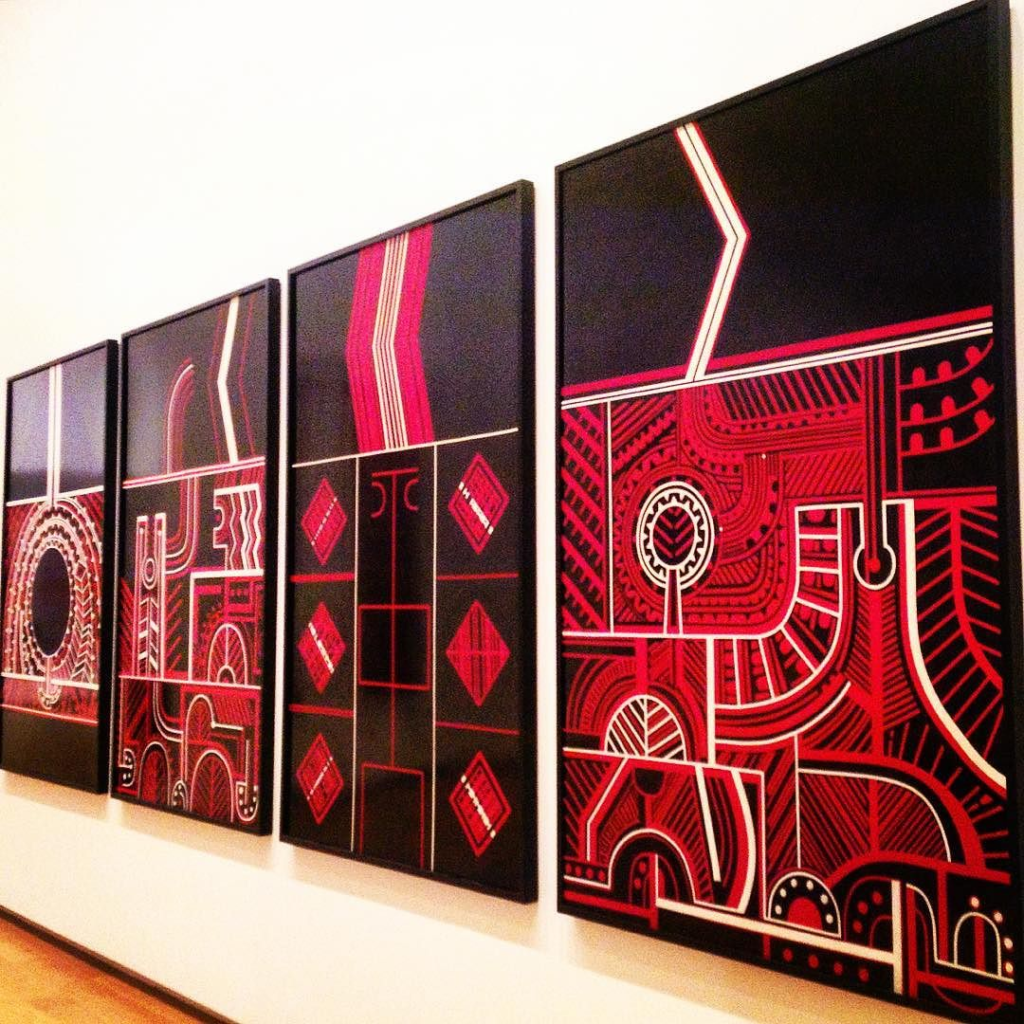
Contemporary/abstract Māori Art. Credit: PARATENE MATCHITT. Link: https://www.heaokotahi.co.nz/blog-1/2017/9/21/burajvk4v9k3oy97xa031d12arx40q European colonization had a profound impact on the role of art and artists within Māori society. Despite persistent efforts to suppress Māori identity and culture, the 1960s and 70s marked the emergence of a cultural revival, coinciding with an increasingly influential political presence. During this period, Contemporary Māori Art emerged as a powerful mode of protest and an expression of Māori identity and convictions. A new generation of artists, influenced by their Māori heritage, urban environments, and Western education, began creating works that blended traditional and non-traditional mediums. They skillfully incorporated techniques from both Māori and European artistic traditions. This fusion of influences gave rise to a vibrant and dynamic art movement. Today, the term ‘Toi’ or ‘Mahi Toi’ encompasses Māori art in all its diverse forms, from the ancient to the contemporary, reflecting the rich tapestry of Māori artistic expression.
Hint – Use SketchUp to quickly produce a couple of concepts:
If you use SketchUp (design software) you could draw the shape and then ‘pull it up’ with the push/pull tool. This will immediately give you a Māori shape. Then, add some more innovation and there you have your Māori-abstract concept.

IMAGE: Can you identify the ‘Flounder’ fish shape – I am looking at the diamond patterned covering of façade? See the 3 x triangular shaped-entrance (half a diamond shape). Contemporary approach using traditional Māori shapes. Imagine typing up an annotation on the prosperity of New Zealand (large quantities of Flounder fish in a net). PARALLEL: You can also refer to the Christian story (Biblical/Western Paradigm) of the disciples who – on the Word of Yeshua – casted their net on the right side of the boat and pulled in so much fish that their net was about to tear. By the way His disciples did not catch any fish that night. It was a miracle! The disciples responded on the Word of Yeshua: “Cast your net on the right hand side of the boat.” Back to the SketchUp image: Rendering from SketchUp of the Scion building used in design presentations. Image courtesy of RTA Studio. Link: https://blog.sketchup.com/article/scion-innovation-hub-the-design-thinking-behind-the-worlds-best-timber-building
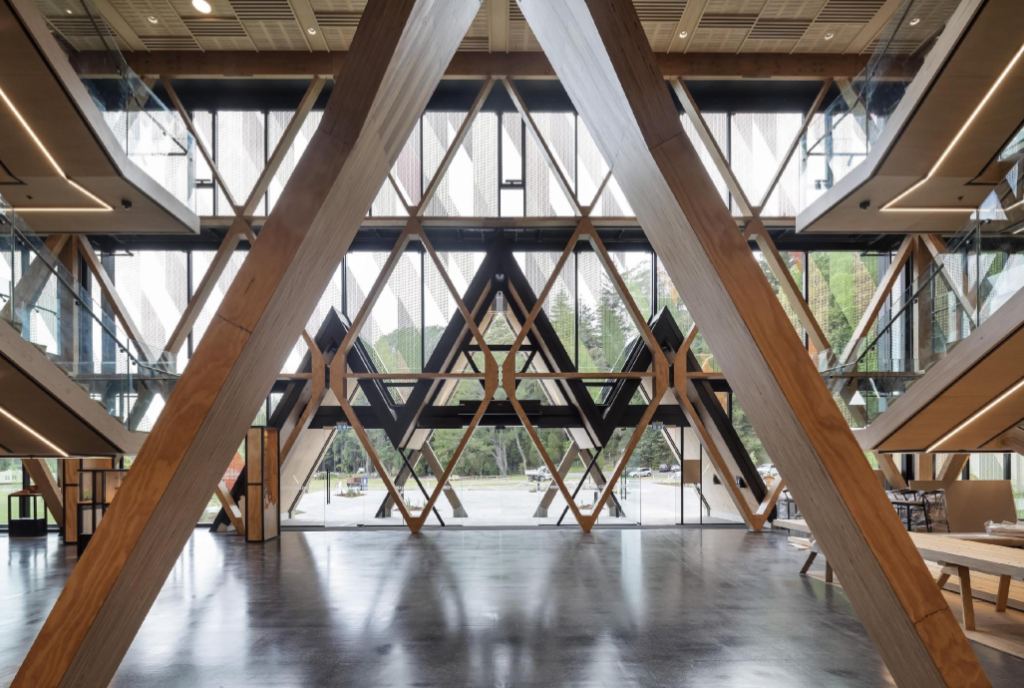
IMAGE: Scion Building – Rotorua New Zealand. Can you see the repeated timber elements from the inside of the building – looking out. As you can gather the triangular shapes are the main elements for the support and structure of the building. Image courtesy of RTA Studio. In collaboration with Irving Smith Architects, RTA Studio was commissioned to reimagine the Rotorua headquarters of Scion, a Crown Research Institute that specialises in technology development for the forestry industry. Link: https://blog.sketchup.com/article/scion-innovation-hub-the-design-thinking-behind-the-worlds-best-timber-building
AI-GENERATED ARCHITECTURE (MIDJOURNEY): Flounder-inspired building.
PROMPT: Flounder fish-inspired building. Focus on the diamond shape of the flounder fish in New Zealand. It could also include some flounder (diamond-shaped patterns).
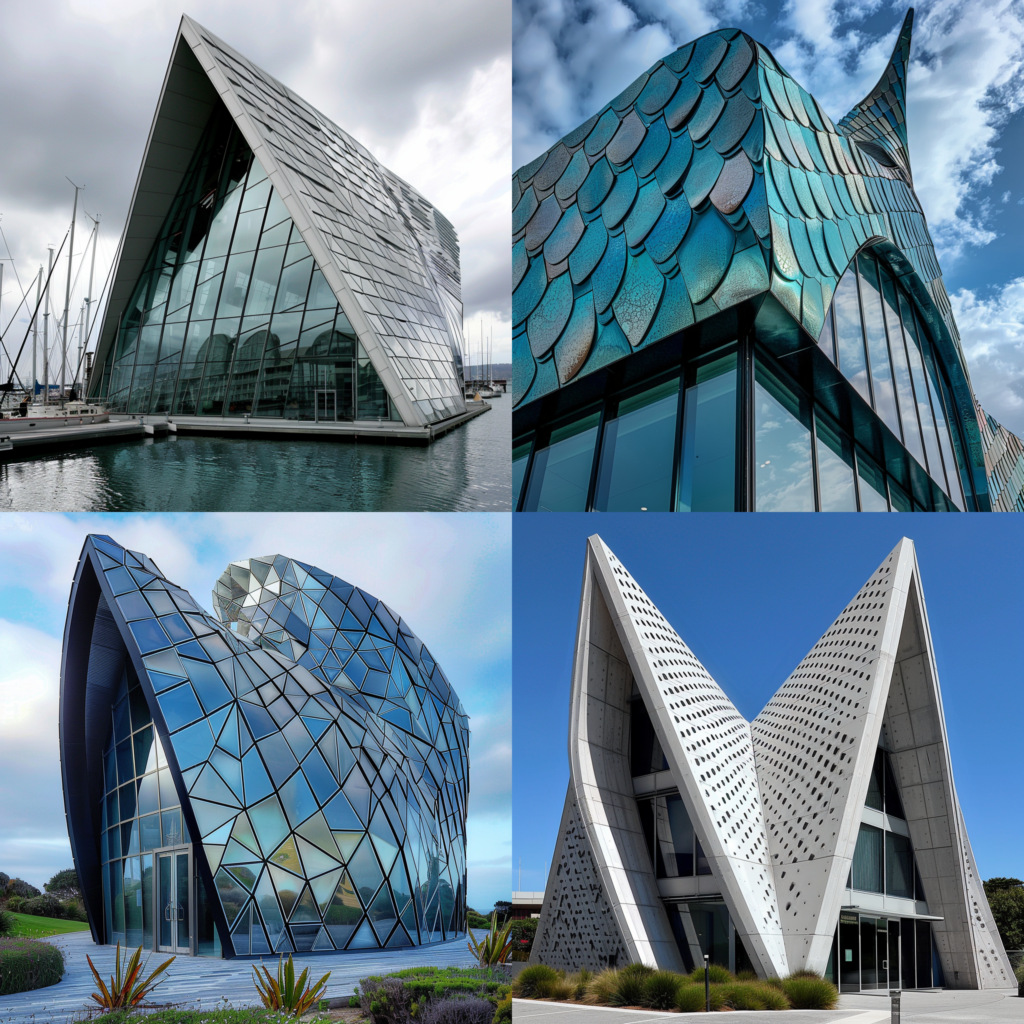
IMAGES: Flounder-shaped inspired buildings (AI-generated).

IMAGE: Can you identify the Flounder (fish) shapes in this building? What could the symbolism be for this building in a Maori context (New Zealand)? What is the meaning of the Patiki symbol (Flounder – diamond shape)? Pātiki or pātikitiki (flounder) designs are based on the lozenge or diamond shape of the flounder fish. They can be quite varied within the basic shape. According to Ngāti Porou tradition, the pātikitiki significance relates to being able to provide 100% – not only for the husband, or the whānau, but for the whole iwi. Could it be physical needs (food) and/or spiritual needs? Could this be a Christian-Māori church or meeting place (Marae)? If you want to include a Christian take on the building you could consider including a Bible verse: “And my God will supply every need of yours according to his riches in glory in Christ Jesus (physical & spiritual).” Philippians 4:19.
It is your turn to be innovative:
PROMPT: What patterns could you use in your Māori-inspired concepts and ideas? Below is an example of abstract Māori artwork that could become the building blocks for an iconic spatial structure.

7IMAGE: Tuku Iho – Canvas Print. Credit Revolution Aotearoa (NZ). Can you identify the triangles (flounder shape)? Where could you use the triangular shapes? Link: https://www.revolutionaotearoa.co.nz/products/tukuiho-canvas-print
Playground AI has followed my prompts- and has produced a stunning Maori-inspired house with triangular shaped structures.
See the full prompt below the image.

PROMPT USED FOR AI GENERATED IMAGE: ‘Design a Maori-inspired house. Include triangular shapes to the façade. Use the diamond shape or the flounder fish as a pattern. Create a simple building by using triangular shapes as the primary support for the structure. Include a modernist style.’ Credit: Playground AI.
Citation:
Van Zyl, W. (2023). Māori Design Principles versus Western Design Principles- comparing and contrasting. Five House Publishing. https://fivehousepublishing.com/2023/08/20/maori-design-principles-versus-western-design-principles-comparing-and-contrasting/
Interested in more Māori resources on architecture, food, fashion, furniture, tools, worldview, AI, and more?
Search the blog posts: ‘Māori‘
Here are some examples of the many articles and resources available: Māori context (metalwork, woodwork, furniture, food, tools, worldview, placenta, AI, Modernist architecture [Le Corbusier – Villla Savoye and others], and much more).
Copyright © 2023 by William Van Zyl
Māori Design Principles versus Western Design Principles – comparing and contrasting.
All rights reserved. This eBook/article or any portion
thereof may not be reproduced or used in any manner
without the publisher’s permission, except for using brief quotations in a book review.
Published by Five House Publishing (New Zealand)
First Publishing, August 2023
More eBooks and articles are available at https://fivehousepublishing.com/
More about the author at http://williamvanzyl.com/